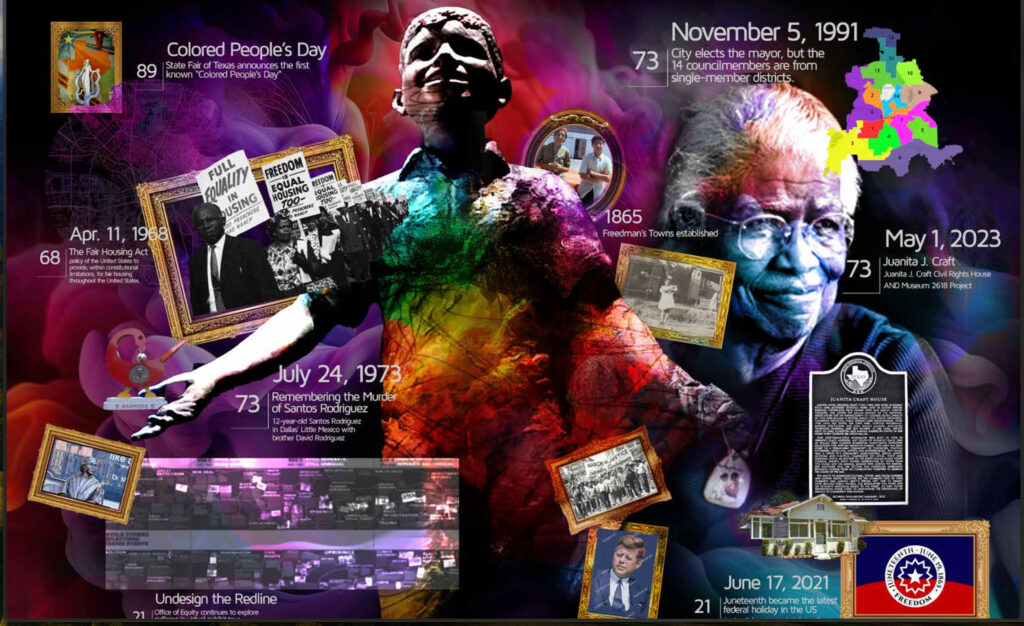Bishop Arts Theatre
To effectively advertise the Bishop Arts Theatre series, a multifaceted approach was crucial. We focused on highlighting the theatre's cultural significance within the Dallas community, particularly its dedication to showcasing African American and multicultural artistic expression. Our strategy involved a blend of traditional and digital marketing.

Black Nativity
For its landmark 20th anniversary, the beloved production of Black Nativity rekindles the spirit of Langston Hughes's groundbreaking 1960 Broadway vision, offering a vibrant and soul-stirring holiday experience. The stage pulses with a palpable energy, where hand clapping rhythms, toe-tapping melodies, and finger-snapping syncopation weave together a tapestry of theatrical wonderment. This cherished tradition brings the timeless Nativity story to life through the electrifying power of Gospel music, the expressive language of dramatic dance, and the resonant beauty of biblical narrative. It's a celebration that invites audiences to not just watch, but to actively participate in the joy and reverence of the season, making it a truly heartwarming and unforgettable experience.

Fannie Lou Hamer
Liz Mikel's return to Dallas marks a significant moment for the city's theater scene, as the beloved Brierley Resident Acting Company member steps into the formidable shoes of Fannie Lou Hamer. After a year on Broadway, Mikel brings her seasoned talent to the regional premiere of "Fannie: The Music and Life of Fannie Lou Hamer," a production poised to resonate deeply with audiences. This one-woman show, a collaboration between Bishop Arts Theatre Center and Dallas Theater Center, promises not just a theatrical experience, but a powerful revival of Hamer's enduring legacy. Mikel's portrayal will illuminate Hamer's journey from impoverished Mississippi sharecropper to fearless civil rights leader, capturing her unwavering commitment to justice and equality. Through a blend of compelling storytelling and uplifting music, the production aims to ignite a sense of shared responsibility and inspire hope, reminding us that even in the face of adversity, the pursuit of a better future remains a collective endeavor.

Jet Fuel
May Evans's set design for the Bishop Arts Theatre Center's production of "Jet Fuel" masterfully evoked the play's intimate and emotionally charged atmosphere. The stage was transformed into a believable, yet subtly stylized, representation of a lived-in, working-class home, reflecting the characters' grounded realities. A warm, muted color palette, dominated by earthy browns, faded blues, and aged yellows, created a sense of lived history and quiet desperation. The furniture, a mix of vintage and worn pieces, suggested a home built over time, rather than a meticulously curated space. Attention to detail was paramount; chipped paint on the window frames, slightly sagging upholstery, and personal knick-knacks scattered throughout the set added layers of authenticity. The lighting, designed to mimic natural light filtering through the windows, shifted subtly throughout the play, mirroring the characters' emotional states and the passage of time. The overall effect was a deeply immersive environment that allowed the audience to fully connect with the characters' struggles and triumphs, making the story resonate with a powerful sense of truth and immediacy.

One Year in Egypt
"One Year In Egypt" plunges audiences into Camika Spencer's transformative year abroad, a journey that shatters preconceived notions and illuminates the complexities of cultural immersion. As a middle school ESL teacher in Al Giza, Egypt, Spencer, an Oak Cliff native, confronts the stark realities of her romanticized vision of Africa, a "wake-up call" delivered with both humor and unflinching honesty. The play serves as a poignant exploration of personal growth, dissecting the intricate layers of race, colorism, geography, history, sexism, class, and education. Through her candid narration, Spencer deconstructs the myths she carried, revealing the nuanced truths of her experience, all while the stage is brought to life with technologically enhanced moments that amplify the emotional and intellectual impact of her story.

1619 Project
In February 2023, the Bishop Arts Theatre Center in Dallas, Texas, served as a vital cultural hub, bringing to life the profound themes of "The 1619 Project, One Act Festival." This theatrical endeavor directly drew inspiration from the groundbreaking Pulitzer Prize-winning work by the New York Times Magazine, "The 1619 Project," which challenges conventional narratives of American history by placing the consequences of slavery at the center of its exploration. Through a series of one-act plays, the festival offered Dallas audiences a unique opportunity to engage with the complex and often painful legacy of slavery, fostering dialogue and reflection on its enduring impact on contemporary society. By translating the powerful written work into a live, dramatic experience, the Bishop Arts Theatre Center provided a platform for artists to reinterpret and amplify the project's central message, making it accessible and impactful for a local audience.

The Sum of Us
For the Bishop Arts Theatre Center's production of "The Sum of Us" as part of the Hamer One-Act Festival, the design should prioritize intimacy and raw emotional honesty within the confines of the space. The set will be minimalist, emphasizing the play's focus on character relationships rather than elaborate scenery. A central, versatile platform or raised area could serve as both the living room and other implied locations, allowing for fluid transitions. Lighting will be crucial, employing stark contrasts and focused pools of light to highlight the characters' emotional states and the play's shifts in tone. Warm, naturalistic tones will dominate, shifting to cooler, more isolating hues during moments of conflict or introspection. Costumes should be contemporary and realistic, reflecting the characters' working-class backgrounds and highlighting their individual personalities through subtle details. Sound design will be used sparingly, primarily to underscore key emotional moments and create a sense of the surrounding environment, using subtle ambient noises to ground the scene. The overall aesthetic should be stripped-down and authentic, allowing the power of the dialogue and performances to take center stage, creating a deeply resonant experience for the audience.

Othello
Franky D. Gonzalez's "Othello" for Bishop Arts Theatre demands a visceral, intimate staging that reflects the play's contemporary, culturally specific lens. The design should evoke a sense of a tightly wound, urban community, perhaps a stylized representation of a Dallas neighborhood, where gossip and social pressures simmer beneath a veneer of normalcy. The set could employ a modular, multi-level structure, allowing for quick transitions between private and public spaces – a bar, a backyard, an apartment – highlighting the claustrophobic nature of the characters' interconnected lives. Lighting should be stark and dynamic, using sharp contrasts and saturated colors to emphasize emotional shifts and the play's heightened reality, mirroring the play's intense emotional core. Costume design should be contemporary and character-driven, subtly revealing social status and personal motivations through specific fabrics, cuts, and accessories, while also nodding to the characters' cultural backgrounds. Sound design should be crucial, weaving in urban soundscapes, contemporary music, and subtle sonic cues to underscore tension and foreshadow events, creating an immersive and unsettling atmosphere that amplifies the play's exploration of jealousy, betrayal, and cultural conflict.

World Classic
For the Bishop Arts Theatre Center's production of "World Classic" by Nelson Diaz-Marcano, the design aimed to evoke a gritty yet vibrant urban landscape, reflecting the play's exploration of community, memory, and resilience. The set, a multi-tiered structure of weathered brick and corrugated metal, suggested a decaying but still-breathing neighborhood, with graffiti art subtly hinting at the characters' histories and struggles. Lighting, a blend of stark streetlamp realism and saturated, almost theatrical hues, punctuated moments of emotional intensity, casting long shadows and highlighting the characters' isolation and connection. The soundscape, a layered tapestry of distant traffic, snippets of salsa music, and the rhythmic pulse of spoken word, created an immersive environment, drawing the audience into the heart of the community. Costumes, a mix of contemporary street style and vintage pieces, reflected the characters' diverse backgrounds and the passage of time, while also emphasizing their individual personalities. The overall design aesthetic was one of raw authenticity, striving to create a visceral and emotionally resonant experience that honored the play's powerful narrative and the spirit of the Bishop Arts neighborhood.

